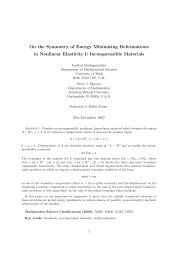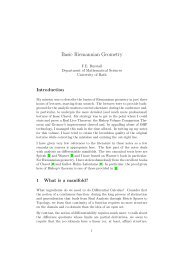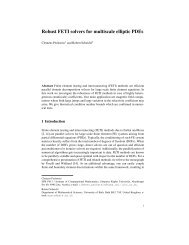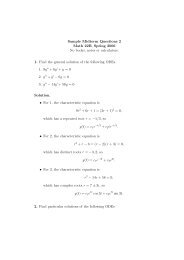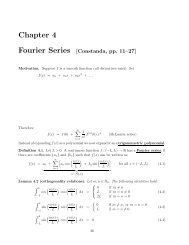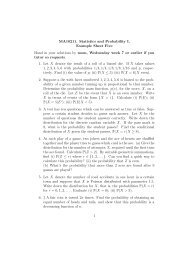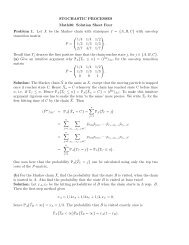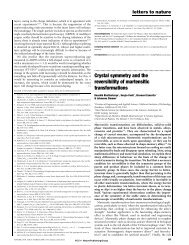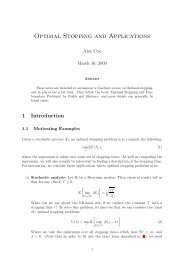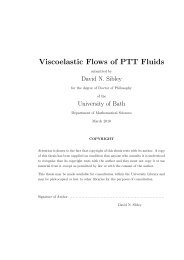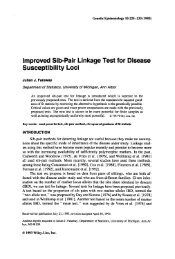1 Lévy Processes and Infinite Divisibility - Department of ...
1 Lévy Processes and Infinite Divisibility - Department of ...
1 Lévy Processes and Infinite Divisibility - Department of ...
You also want an ePaper? Increase the reach of your titles
YUMPU automatically turns print PDFs into web optimized ePapers that Google loves.
specific distributions, most <strong>of</strong> them are non-trivial, <strong>of</strong>ten requiring intimateknowledge <strong>of</strong> special functions. A brief list <strong>of</strong> such distributions might includegeneralised inverse Gaussian (see [5] <strong>and</strong> [14]), truncated stable (see [30], [8],[15], [1] <strong>and</strong> [2]), generalised hyperbolic (see [7]), Meixner (see [24]), Pareto (see[25] <strong>and</strong> [28]), F-distributions (see [10]), Gumbel (see [13] <strong>and</strong> [26]), Weibull(see [13] <strong>and</strong> [25]), lognormal (see [29]) <strong>and</strong> Student t-distribution (see [6] <strong>and</strong>[9]). See also the book <strong>of</strong> Steutel [27]Despite being able to identify a large number <strong>of</strong> infinitely divisible distributions<strong>and</strong> hence associated <strong>Lévy</strong> processes, it is not clear at this point what thepaths <strong>of</strong> <strong>Lévy</strong> processes look like. The task <strong>of</strong> giving a mathematically preciseaccount <strong>of</strong> this lies ahead in the next section. In the meantime let us make thefollowing informal remarks concerning paths <strong>of</strong> <strong>Lévy</strong> processes.Exercise 1 shows that a linear combination <strong>of</strong> a finite number <strong>of</strong> independent<strong>Lévy</strong> processes is again a <strong>Lévy</strong> process. It turns out that one may consider any<strong>Lévy</strong> process as an independent sum <strong>of</strong> a Brownian motion with drift <strong>and</strong> acountable number <strong>of</strong> independent compound Poisson processes with differentjump rates, jump distributions <strong>and</strong> drifts. The superposition occurs in sucha way that the resulting path remains almost surely finite at all times <strong>and</strong>,for each ε > 0, the process experiences at most a countably infinite number<strong>of</strong> jumps <strong>of</strong> magnitude ε or less with probability one <strong>and</strong> an almost surelyfinite number <strong>of</strong> jumps <strong>of</strong> magnitude greater than ε, over all fixed finite timeintervals. If in the latter description there is always an almost surely finitenumber <strong>of</strong> jumps over each fixed time interval then it is necessary <strong>and</strong> sufficientthat one has the linear independent combination <strong>of</strong> a Brownian motion withdrift <strong>and</strong> a compound Poisson process. Depending on the underlying structure<strong>of</strong> the jumps <strong>and</strong> the presence <strong>of</strong> a Brownian motion in the described linearcombination, a <strong>Lévy</strong> process will either have paths <strong>of</strong> bounded variation on allfinite time intervals or paths <strong>of</strong> unbounded variation on all finite time intervals.Weincludesixcomputersimulationstogivearoughsense<strong>of</strong>howthepaths<strong>of</strong><strong>Lévy</strong>processeslook. Figs.1<strong>and</strong>2depictthepaths<strong>of</strong>Poissonprocess<strong>and</strong>acompoundPoissonprocess, respectively. Figs.3 <strong>and</strong> 4 show the paths <strong>of</strong> a Brownianmotion<strong>and</strong>theindependent sum<strong>of</strong>aBrownianmotion<strong>and</strong>acompoundPoissonprocess, respectively. Finally Figs.5 <strong>and</strong> 6 show the paths <strong>of</strong> a variance gammaprocess <strong>and</strong> a normal inverse Gaussian processes. Both are pure jump processes(no Brownian component as described above). Variance gamma processes arediscussed in more detail later normal inverse Gaussian processes are <strong>Lévy</strong> processeswhose jump measure is given by Π(dx) = (δα/π|x|)exp{βx}K 1 (α|x|)dxfor x ∈ R where α,δ > 0, β ≤ |α| <strong>and</strong> K 1 (x) is the modified Bessel function <strong>of</strong>the third kind with index 1 (the precise definition <strong>of</strong> the latter is not worth thedetail at this moment in the text). Both experience an infinite number <strong>of</strong> jumpsover a finite time horizon. However, variance gamma processes have paths <strong>of</strong>bounded variation whereas normal inverse Gaussian processes have paths <strong>of</strong>unbounded variation. The reader should be warned however that computersimulations ultimately can only depict a finite number <strong>of</strong> jumps in any givenpath. All figures were very kindly produced by Antonis Papapantoleon.15



